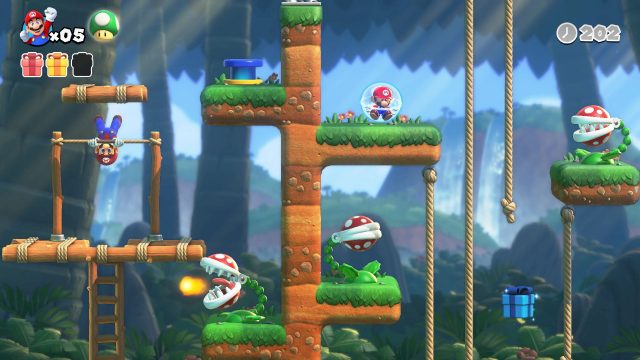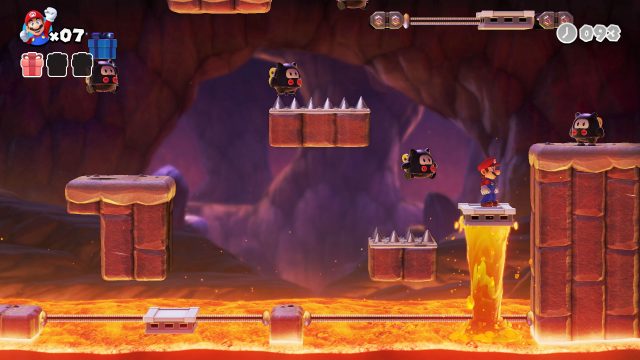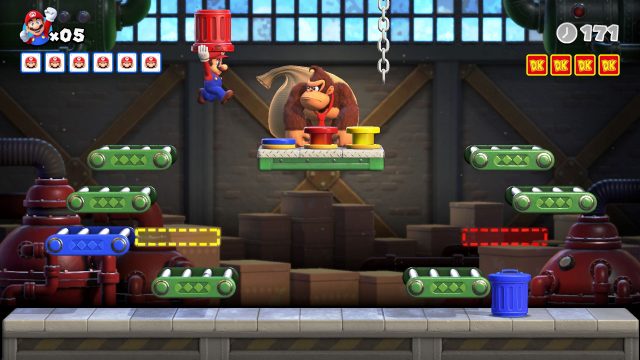Genuinely challenging brain teasers that get increasingly difficult; Well-paced ramp up in difficulty; Fantastic soundtrack; Mario feels great to control; Creative uses of enemies to bypass traps and chasms; Post-game levels introduce new mechanics that up the difficulty
Fights against Donkey Kong felt a little too easy; The final fight was unnecessarily frustrating; Changes to Mario's dialogue are a little boring and stale; Mini Mario stages felt tedious
Game Boy Advance (GBA) was an amazing little handheld that gave us quite the variety of games, from RPGs to platformers, racing games to motion-controlled titles, puzzle games, and more. 2004’s Mario vs. Donkey Kong was a unique puzzle-platformer that tasked players with guiding Mario through a series of two-part levels, with the way forward requiring some puzzle-solving and working through brain teasers. It was reviewed positively and got a sequel, Mario vs. Donkey Kong 2: March of the Minis, on Nintendo DS in 2006.
Eighteen years later, Nintendo decided to finally return to the much-loved GBA title with the remake, Mario vs. Donkey Kong, for Nintendo Switch. I played only some of the original game back in 2004, so I didn’t go into this with a ton of nostalgia or expectations about gameplay. But I think this remake did a really great job of keeping the very best parts of the 2004 game and introducing some new, fun content to keep things feeling fresh.
The premise is charming in how goofy it is. Mario owns a toy company that produces mini, wind-up Mario toys. Donkey Kong sees a commercial for the toys while channel surfing one day and instantly becomes obsessed with them — and takes the tagline “buy one, buy them all” literally. After rushing to his nearest toy store and finding them sold out, he decides to go to the source: the Mini Mario factory. After stealing the factory’s stock and stuffing them all in a burlap sack, he gets chased down the street by Mario, and the quest begins to get back his stolen property.
There are eight worlds with six levels a piece, plus one Mini Mario-centric stage and a boss fight with Donkey Kong. Each stage is separated into two parts. The first requires you to grab a key to open the door locking the path forward; the second leads you to more traps and puzzles you have to navigate to reach the Mini Mario trapped at the end. Things start off pretty straight forward in the early worlds of the game and then get harder, but at a good pace. It didn’t feel like there was a sudden difficulty spike from one world to the next.
You only have a limited amount of time to get through each stage, though you’re given additional seconds once you reach part two. And as the difficulty increases and you need some more time to consider how to solve each puzzle, you can hold down the R button to stop time and scan the camera across the stage.
Mario has an interesting move set that focuses on his acrobatics. In addition to his jump (which is heavier and doesn’t get him as much air as in mainline Mario games), he can also do a handstand that protects him from falling debris, his backflip, an upward spin-and-flip off of bars, and can climb up, down, and across hanging ropes and chains. And while most enemies can one-hit K.O. Mario, he can also use them to his advantage in what I felt were pretty creative ways. Throw toy Shy Guys and Snifits into spike pits that they can walk across without taking damage and hitch a ride on their heads! Hang onto the tail of a toy monkey as it walks over an otherwise impassable chasm!
The goal of the Mini Mario stages is a little different than the main stages: lead the Mini Marios you’ve saved through the hazards of a level to collect the letters “T-O-Y” and then gather them all up in a toy box. I never looked forward to these stages and felt like they were more tedious than fun, though I did find it cute how the Mini Marios call out in tiny voices for Mario to come back if he strays too far from them.
Mario feels good to control and the puzzle solving is genuinely fun. I found myself hooked pretty quickly, eager to see what the next challenge was or what new technique the game would teach me. However, while the stages could be difficult (in a good way), I never really felt like the fights against Donkey Kong were, even in the later worlds. The exception to this was the final boss fight, which was unnecessarily frustrating. Donkey Kong, high up on a scaffolding, throws down a giant DK barrel. But you can’t grab it until it hits the ground, rolls off-screen, and is carried back by three Toads you have to first save from Donkey Kong’s clutches. Then you can grab it and hop all the way up to the top, avoiding spiky barrels falling erratically around you.
If one hits you, Mario drops the DK barrel (which gets destroyed), meaning you have to drop all the way down and repeat the whole process again. The patterns of the spiky barrels were too erratic to read and it didn’t feel like there was much room (literally) for error. And with the timer ticking away, you needed to be pretty accurate through the whole battle or risk running out of time just due to how long it would take for the DK barrel to hit the ground and the Toads to bring it back. This was an annoying battle that soured me a bit on the whole experience given how great the rest of the game felt.
Post-game content is significant. After beating Donkey Kong the first time, 48 new stages unlock across the same eight worlds, but this time they’re more difficult from the start (and only get harder). You also have a Mini Mario tagging along with you to help you solve the puzzles, introducing the Mini Mario mechanic into the gameplay rather than relegating it to the Mini Mario stages.
Fans of co-op will be happy to hear the remake has introduced two-player functionality. Player Two controls Toad, who shares Mario’s move set. And, much like in the New Super Mario Bros. games, if one of the players is hit, they’ll float on-screen in a bubble as opposed to just getting K.O.’d.
The soundtrack for this game was surprisingly strong. The OST from the 2004 game was pretty solid, but the remake’s OST is jazzy and catchy all the way through. Twilight City had my favorite tracks in the game, evoking a very noir film-inspired, moody sound that I absolutely loved.
In the 2004 game, there were two minigames after each level involving the presents that you can collect in each stage. Those have been eliminated and replaced with a new minigame, where Mario chases around a flying key to try to unlock a treasure chest filled with 1-ups before time runs out. Definitely a little less zany than the original games, but also provides the player with an opportunity to get around seven or eight 1-ups once per world.
My only other complaint: much of Mario’s personality was stripped from the original game in this remake. If you watch the original game’s intro and compare it to the remake’s, Mario’s dialogue is so much more limited and sterile this time. In the 2004 game, when Mario confronts Donkey Kong outside of the toy factory, he says, “No you don’t… no you don’t!” He then exclaims, “What’s goin’ on here??” and starts to ramble in befuddled, angered Italian gibberish. Mario and Luigi’s Italian gibberish is one my favorite things about the Mario & Luigi games and was just as good in this game. I’m not sure if Nintendo thought they should remove it because it was offensive or something, but as a part-Italian myself I was never offended by it and just sad to see it gone. Now, Mario just calls for Donkey Kong to come back. I also miss Donkey Kong’s enthusiastic “Hey, cool!” as he’s scooping the Mini Marios into his bag.
The cutscenes are nicely rendered, and the opening scene was remade very well. (I really appreciate the more animated, intense gestures of the Shy Guy news anchor.) But I do think the original captures the goofiness of the game just a little better, particularly the way the camera flits back and forth between Donkey Kong, unmoving, watching the TV, and the Mini Mario commercial, and then zooms in on his face at the end, still with the same expression but now with heart eyes. Nintendo seems like they wanted to pull back a little from the quirkiness and weirdness of the GBA version of the game. That’s a shame and is an unfortunate commonality among many of their remakes.
Whether you played the 2004 version of Mario vs. Donkey Kong or are just stepping into the series, I recommend giving this remake a go. It’s a fun game that feels great to play and offers a good challenge, and because it was a game initially made for GBA, it’s good for pick-up-and-play bursts. It’s also a nice change of pace from typical Mario games, and a great example of the sort of creative, unique titles that came out of the GBA era (and have aged well).




 ShareThis
ShareThis








